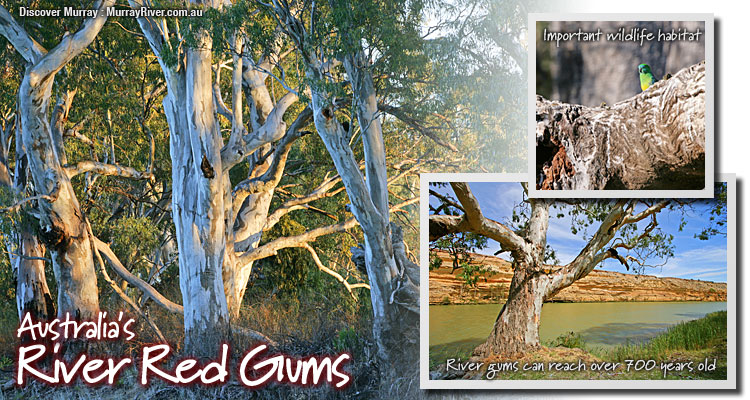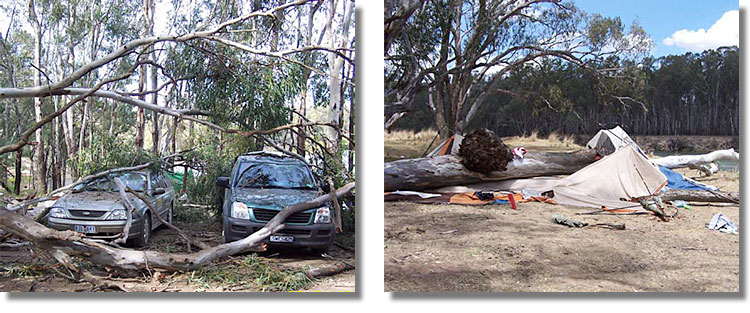
Australia's river redgums - Eucalyptus camaldelensis

The river red gum Eucalyptus camaldulensis is the most widely distributed eucalyptus species in Australia growing along watercourses throughout the country. It lines the Murray River for most of its length. The trees are usually 20–35 m high with some over 45 m, with a diameter of 1–3 m. Canopy is dark green and the forest floor is usually devoid of undergrowth. The trunk is vari-coloured, which includes patches of leaden grey bark above an area of brown-black. The branches are often twisted and the root system is often partly exposed.
It is the association with the water that makes the tree interesting. It needs periods of partial flooding where its trunk may be inundated for months. Seeds are washed to high ground during a flood and germinate to take root and grow before the next flood submerges the new tree.
Old rotten limb hollows, or broken branches, provide nesting hollows for galahs, sulphur-crested cockatoos, gang-gang cockatoos, cockatiels and various parrots.
The timber is a reddish colour with a strong interlocking grain. It is hard and durable and is renowned for its slow-rotting character. The hard, heavy red gum provides foundations for buildings, and timber for railway sleepers, wharves and fences. It polishes beautifully and sometimes turns well.
Flowering is usually in summer in Victoria and varies in New South Wales. The flowers are white to pale cream. Honey produced has a clear golden colour, is mild and of good flavour.
Eucalyptus oil is well known in the pharmaceutical industry for a variety of products such as cough lozenges, inhalations, linaments and mouth washes. It comes mainly from E. globulus but some is derived from E. camaldulensis, but it is in the supply of eucalyptus gum that the river red gum leads the field.
The Aborigines used the tree for its medicinal properties. A handful of young leaves, crushed and then boiled in water, was used as a linament that was rubbed in for chest or joint pain, particularly for general aches and flu symptoms. Young leaves were also heated in a pit over hot coals, and the vapours were inhaled, which helped with the treatment of general sickness.
Beware of the falling trees!
 |
||
| These campers and visitors were lucky to escape unharmed when trees and limbs fell on their vehicles. You can see from the photographs how large some of the trees and limbs are, hence the importance in setting up camp and parking well AWAY from trees. | This tree fell on New Years Day 2006 near Cobram. At the time the tree fell there was a person in the tent and luckily, the person was unharmed. This illustrates just how risky camping near trees can be. | |
There are risks involved in being outdoors but there are things you can do to minimise the risk to you and others. One of the risks in the parks and reserves along the Murray River is trees falling or dropping limbs. Trees can drop limbs, or entire trees can fall, without warning and there is no way of determining when a tree might fall or drop a limb. Trees may be particularly prone to dropping a limb or falling when they are under stress. This stress may include:
- High wind
- Extreme temperatures or sudden changes in temperature
- Drought
- Fire
- Compaction
- Flood
When a tree falls there is no way of predicting which way it will fall so it is important to stay clear of trees in all directions.
A limb falling from a tree often does not fall straight down. The limbs may bounce against other limbs and swing out well beyond the drip line (the edge of the canopy) of the tree.
River Red Gums drop branches
River Red Gums are unique to the Australian bush and grow along the waterways as well as in other areas where water is not apparent at surface level. In fact River Red Gums are the most widespread eucalypt in Australia. They propagate when floodwaters run high and can live up to 700 years or more.
A feature of River Red Gums is that they drop their limbs in times of drought to conserve water. The hollows created by the falling of the limbs are ideal homes to a host of wildlife, making the River Red Gum a magical ecosystem along the inland waterways of the Australian bush.
The Murray River's Red Gums are particularly prone to dropping large branches at any time without warning. This is why the safest place for all visitors to enjoy a rest, pitch their tent, park their car or have a picnic is in a clear area AWAY from large trees.
However, the risk of falling limbs applies not only to River Red Gums, so be sure to stay well clear of ALL trees regardless of their type.
Be safe, not sorry
As there is no way to predict exactly when a tree might fall or drop a limb it is ALWAYS better to be safe than sorry.
Tell your friends you found this at murrayriver.com.au!
Copyright Discover Murray 2025. This site or any portion of this site must not be reproduced, duplicated, copied, sold, resold, or otherwise exploited for any commercial purpose that is not expressly permitted by DISCOVER MURRAY.






 The Royal Edinburgh Military Tattoo 2023 - Arts On Screen
The Royal Edinburgh Military Tattoo 2023 - Arts On Screen Anh Do The Happiest Refugee Live!
Anh Do The Happiest Refugee Live! Big Band Christmas Bash 2023
Big Band Christmas Bash 2023 Native Flower Showcase
Native Flower Showcase CREEDENCE CLEARWATER COLLECTIVE
CREEDENCE CLEARWATER COLLECTIVE